"Here's how we saved works from the 2016 earthquake." Curators of the "Marche Renaissance" exhibition speak.
Fifty-one works from the sites of the 2016 central Italian earthquake will soon return to the cities and towns of the crater, from which they came: first, however, they will be displayed in a three-stage exhibition, entitled Renaissance in the Marche. Works of Art Restored from Earthquake Sites, which will kick off Nov. 22 in Ascoli Piceno, at the Malatesta Fortress. The Ascoli stop will run until Feb. 2, after which the exhibition will first move to Rome, at the Pio Sodalizio dei Piceni (Feb. 18 to July 5, 2020), and then to the Palazzo del Duca in Senigallia (July 23 to Nov. 3, 2020). For the public, the opportunity is not only to see masterpieces of ancient art from the 15th to the 18th century, but also to understand what it means to save works from a natural disaster. We talked about this with the curators, art historian Stefano Papetti, with whom we discussed the exhibition, and superintendence official Pierluigi Moriconi, one of the protagonists of the rescue of the works, with whom we recalled the terrible moments of 2016 and were told what it means to work on cultural heritage during an earthquake event. The two interviews are edited by Federico Giannini, editor in chief of Finestre Sull’Arte.
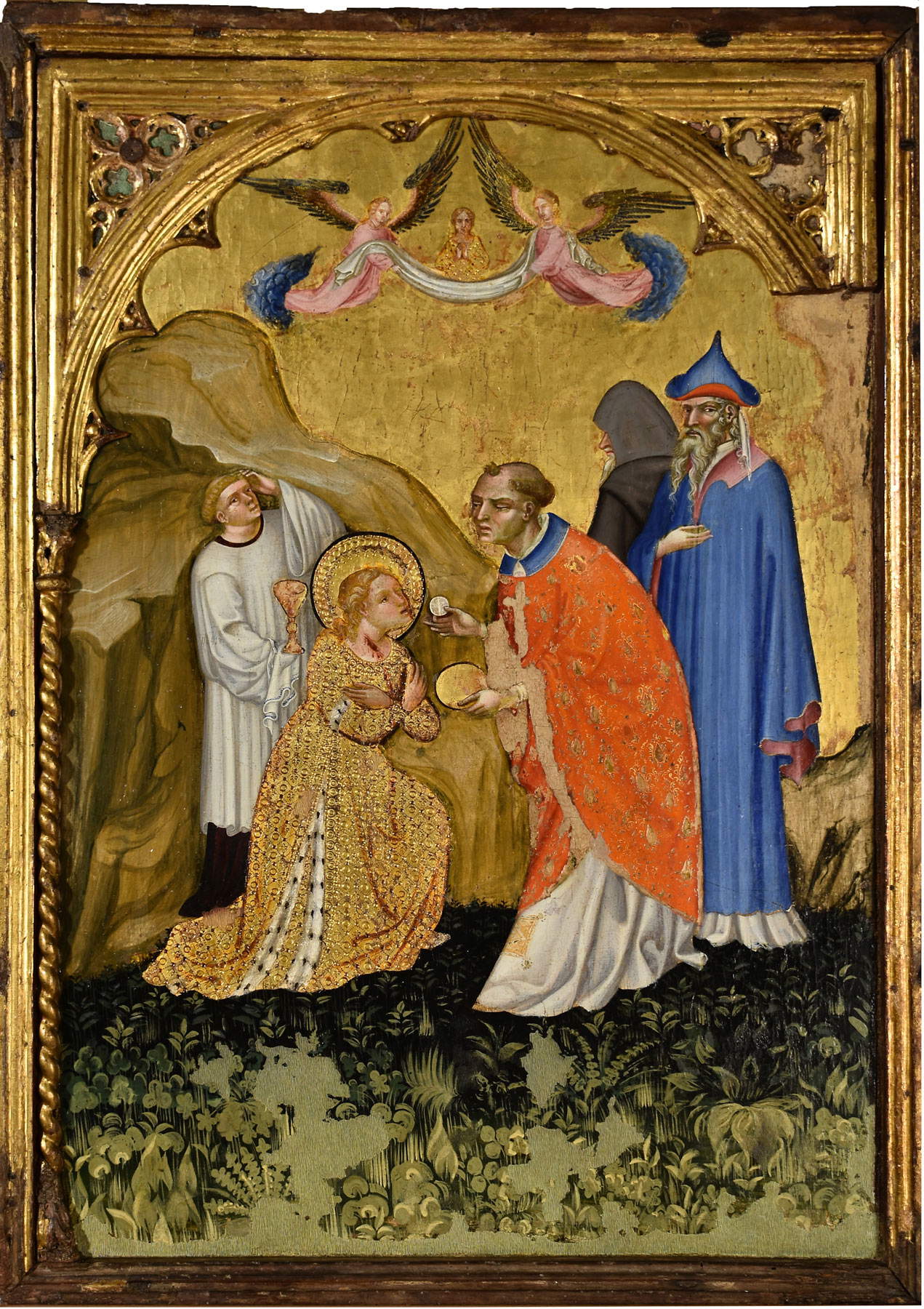 |
| Jacobello del Fiore, Scenes from the Life of Saint Lucy Lucy Receives the Eucharist (c. 1410; tempera and gilding on panel, 60 x 80 cm; Fermo, Pinacoteca Civica, Palazzo dei Priori) |
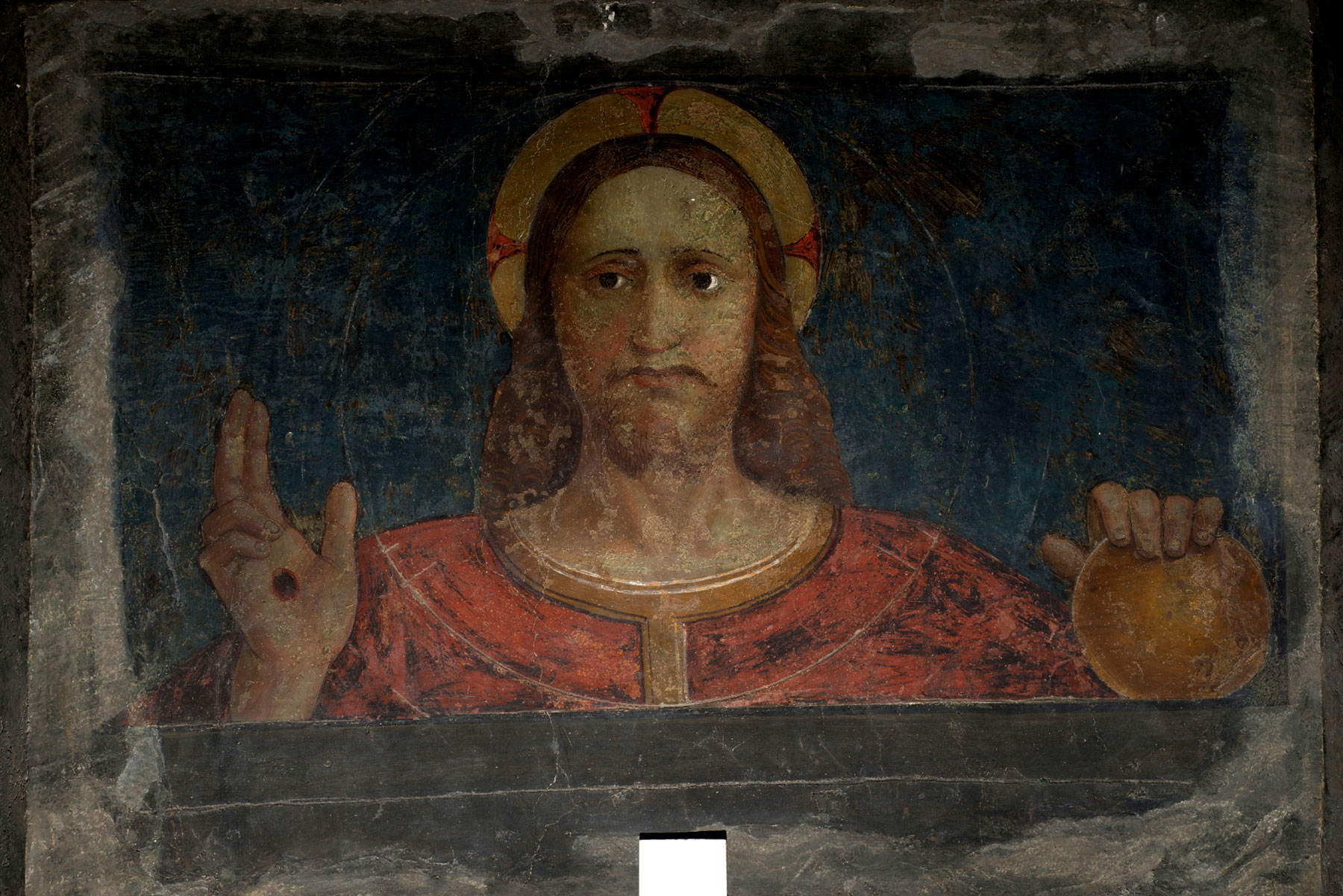 |
| Cola dellAmatrice, Christ Blessing (c. 1520-1530; fresco detached in solids from the church of Santa Margherita, 77 x 97 cm; Ascoli Piceno, Pinacoteca Civica) |
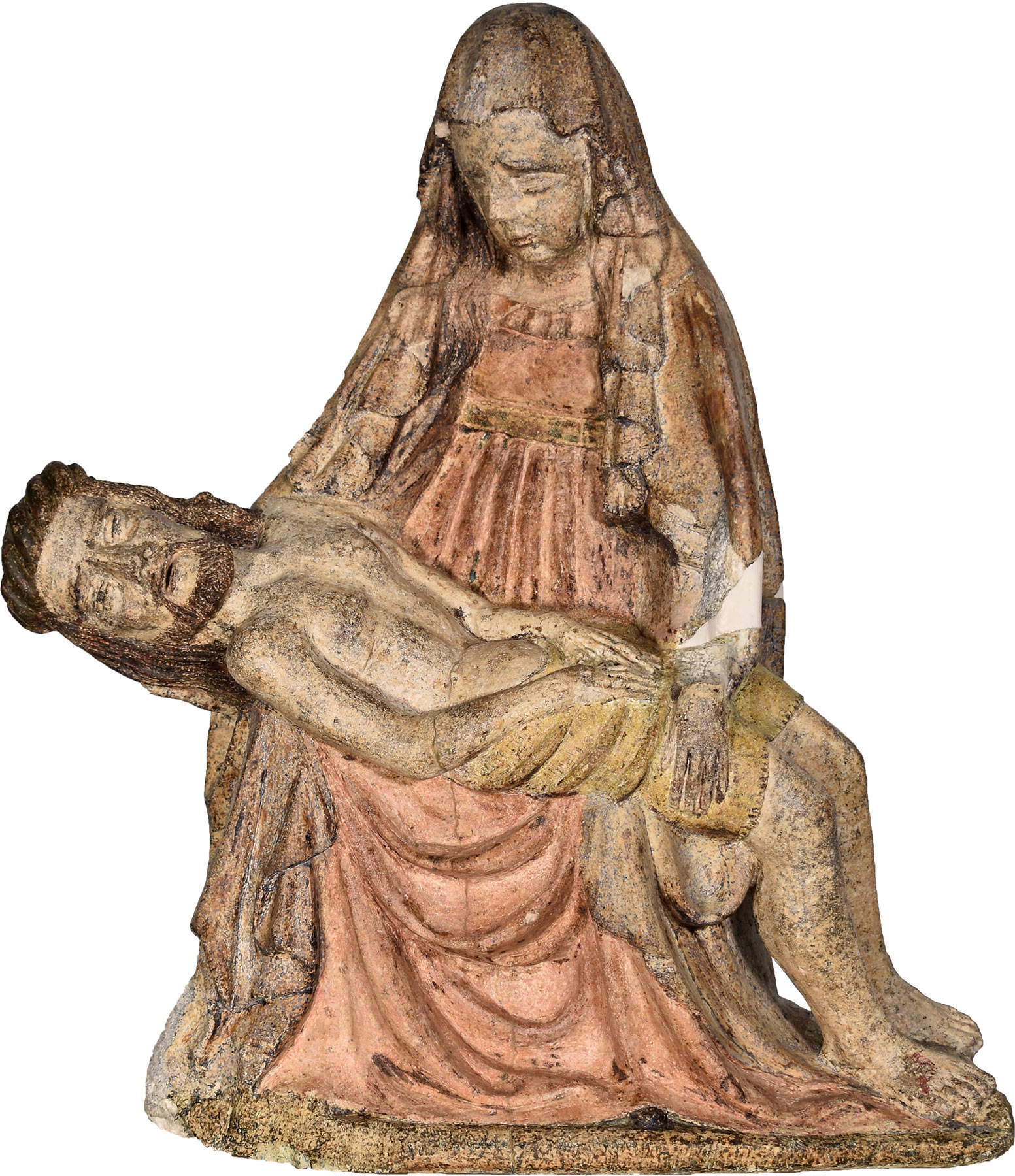 |
| German Ambit, Madonna with the Dead Christ or Vesperbild known as Madonna della Cona (second half of 15th century; painted stone sculpture, 57 x 49 x 19 cm; Castelsantangelo sul Nera, locality Forca di Gualdo, church of the Madonna della Conaora; preserved in Ancona, Mole Vanvitelliana, MiBAC emergency movable property depository, location H5a) |
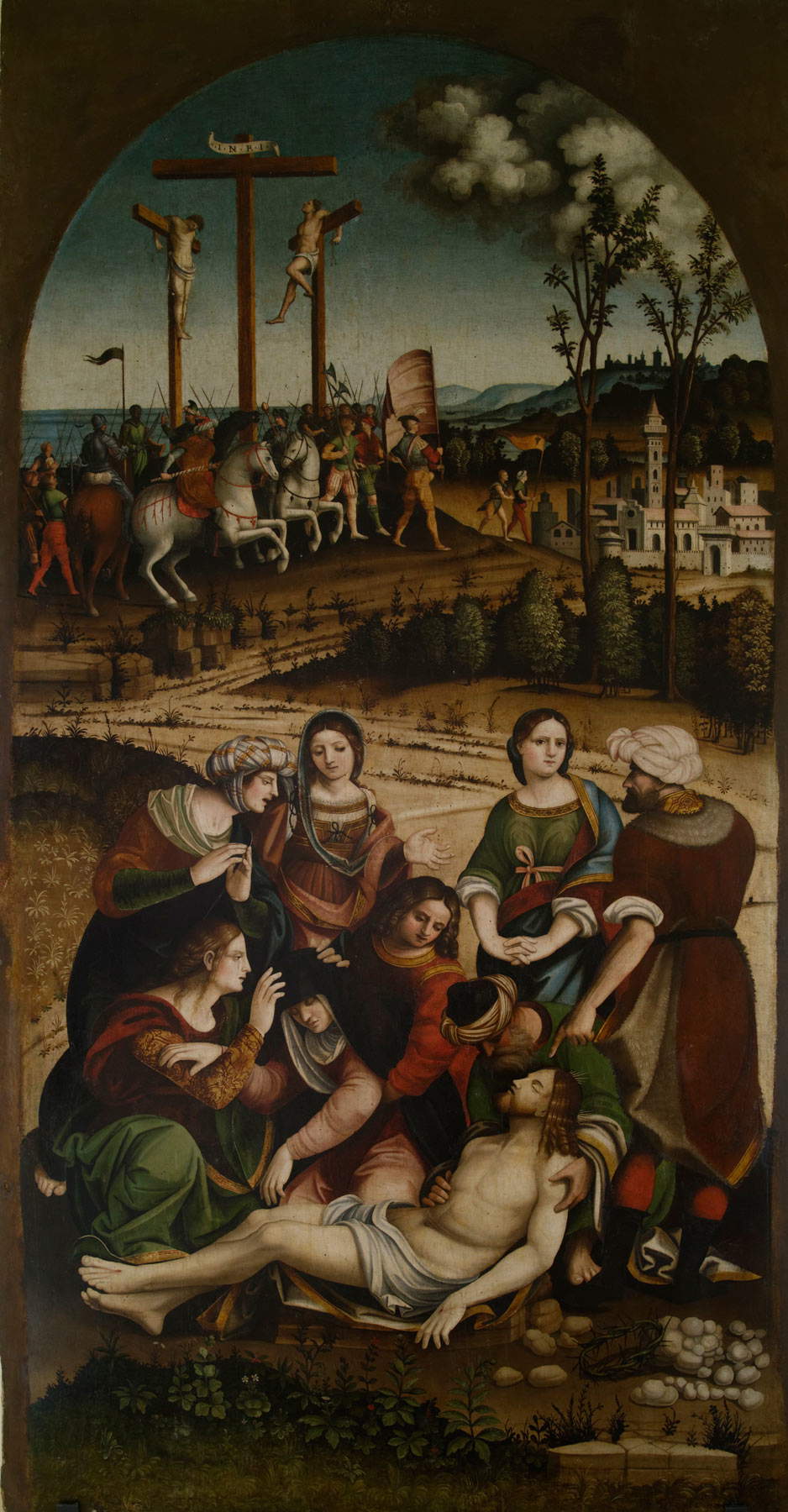 |
| Vincenzo Pagani, Lamentation over the Deposed Christ (1529; oil on ribbed panel, 277 x 148 cm; Sarnano, Pinacoteca Civica Rete Museale dei Sibillini) |
Federico Giannini. What are the reasons that led to the creation of this type of exhibition, and why was a formula chosen that made it itinerant, bringing the works affected by the earthquake even to areas far from those affected by the earthquake?
Stefano Papetti. The exhibition is part of a larger project that began two years ago thanks to the financial support of the National Association of Italian Municipalities and the Pio Sodalizio dei Piceni, which provided 400,000 euros for the restoration of works of art from the earthquake sites, so the curiosities and municipal museums in the Marche region identified the works that were most important and most in need of restoration: restorers from the Marche were all involved, and at the end of this campaign it was planned to present what had been achieved first in Ascoli Piceno (thus in a city included in the earthquake crater), then in Rome, at the Pio Sodalizio dei Piceni, which gathers the Marche people present in that city and which contributed financially to the restoration of the works, and finally in Senigallia during the summer period. Most of the works that have been restored come from places, churches and museums that have not yet been restored or at any rate in some cases have even collapsed, so once restored they would not have been able to return to their places of origin. Exhibitions such as this serve, on the one hand, to make known the work done and the results obtained thanks also to the investigations conducted on these works, which open up new knowledge about the history of art in the Marche region, and then to give even those who do not reside in the localities affected by the earthquake the opportunity to see the interventions made and, through these interventions, to take an interest in the places of origin of the works. But above all, this exhibition can be an injection of confidence and energy for all those families who, three years later, still hope to return to their earthquake-damaged homes.
FG. The exhibition starts with the identification of 51 works from the Marche region, owned by 17 different entities, undergoing restoration. How was this done, on what criteria were the works identified for restoration?
SP. The works were identified by the owners of the works themselves, then by the dioceses in the Marche and by the municipal administrations. They were chosen on the basis of two criteria: in some cases, on the basis of their importance for the history of art in the Marche (there are absolute masterpieces such as Jacobello del Fiore’s Stories of St. Lucy that come from Fermo, or Vittore Crivelli’s painting that comes from Sarnano), and in other cases the devotional aspect was looked at, especially where the buildings of worship have been so badly damaged that it is now certain that they will never be rebuilt. And it was precisely to keep the memory of those places alive that it was decided to restore the movable works of art that were extracted with great difficulty by the firefighters and carabinieri of the Nucleo Tutela Patrimonio Culturale from the rubble produced by the collapses of numerous historic buildings.
FG. What will be the fate of the works from the places that will not be rebuilt?
SP. At the end of the exhibition, the works that will be able to return to the structures of origin that in the meantime have been restored and made fit for use will obviously be returned to their original locations; those that cannot return will be placed, depending on their origin, in one of the eight repositories that in the meantime the Ministry of Cultural Heritage has set up in the Marche region and that will be open to the public.
FG. In the exhibition, however, we will not see all of them, because the departure in Ascoli Piceno will be entrusted to a selection of 37 works. On what basis was this selection made?
SP. It was made on the basis of the progress of restoration work. Fourteen works are not present because the interventions have turned out to be more complex than originally thought, so they are still in progress. Certainly, on the occasion of the Roman trip, other paintings on which work has been done in the meantime will be added to those present in Ascoli Piceno
FG. What are the main innovations that have emerged from the restorations?
SP. All major restoration interventions were preceded by a series of diagnostic investigations on the works carried out by the spin-off “Art and Co.” of the University of Camerino coordinated by Graziella Roselli, which have been indispensable for restorers but also very useful for the history of art: for example, the fact of being able to see, thanks to reflectographs, the preparatory drawings and the modifications made during the course of the work by the painters, has opened a very important chapter regarding not only the conservation of these works but also the vicissitudes of the artists who were involved. So we have, for example, many attributive novelties concerning Cola dell’Amatrice or the painters active in our region between the seventeenth and eighteenth centuries, such as Giovanni Baglione, Cavalier d’Arpino and Étienne Parrocel. The catalog gives an account of the results of the investigations carried out on the works on display and the restoration work carried out.
FG. In your introductory essay you state that the three exhibitions in Ascoli, Rome and Senigallia, will be opportunities to “raise public awareness about the problems related to the preservation of artistic heritage in the areas affected by the earthquake”: what does this mean in concrete terms? How do you intend to raise awareness among visitors and the public in general, precisely, and how do you plan to achieve the goal?
SP. Of course, the exhibition deals with movable works of art (paintings and sculptures that were secured in the weeks following the earthquake), but the aspect that we would like to bring to the attention not only of public opinion, but also of those whose task it is to protect artistic heritage, is the fact that most of the buildings from which these works come have not yet undergone restoration, so in the face of very substantial interventions (also thanks to the generosity of associations and nonprofit organizations) the movable works of art are well protected and preserved, but the same cannot be said for the architectural heritage.
FG. Has policy shown interest in the heritage affected by the earthquake, or do you still encounter difficulties?
SP. It seems to me that, seeing the slowness with which we proceed not only with restoration work (much of which has yet to begin), but also with the procedures for getting to restoration, there is not much awareness, on the part of the administration, of the urgency to intervene: there is no realization that bureaucracy, made even more rigid precisely on the occasion of the earthquake, represents a brake that slows down interventions in such a way that today only very few construction sites have been started.
FG. Why should visitors go to see the three exhibitions?
SP. First of all because, in the case of the Fort Malatesta exhibition, it is an opportunity to enrich an artistic heritage, that of Ascoli, which although scarred by the earthquake, is largely usable. In fact, it could represent a pretext to then visit the city and to deepen the knowledge of the Marche’s immense historical-artistic heritage through some masterpieces that are placed in a very long chronological period, ranging from the mid-fifteenth century to the early twentieth century. And finally, the arrival of tourists also represents a breath of fresh air for the economy of the entire Apennine territory, which the earthquake has greatly compromised.
Below is the interview with Pierluigi Moriconi.
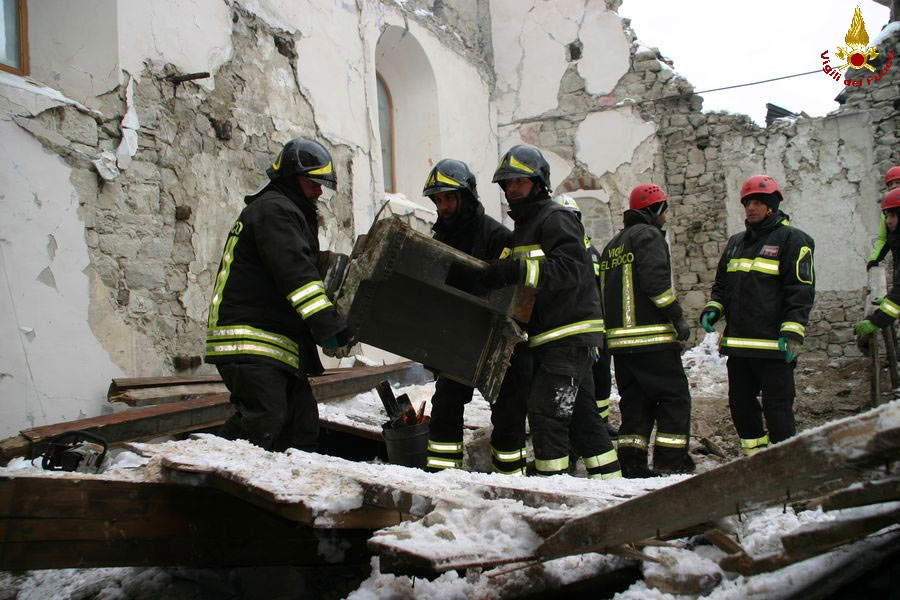 |
| Saving works from the Annunziata parish church in Arquata del Tronto (photo National Fire Department) |
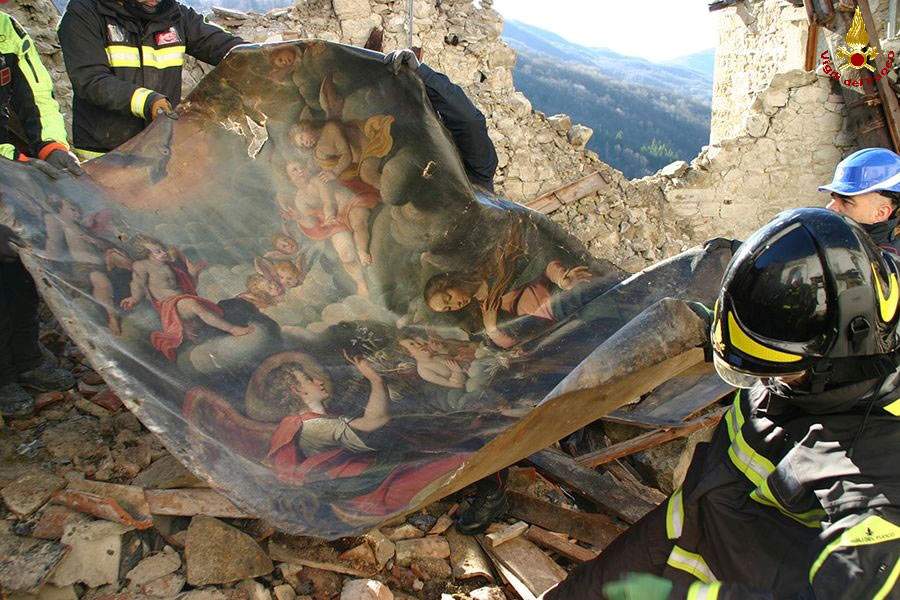 |
| Rescuing works from the Annunziata parish church in Arquata del Tronto (photo National Fire Department) |
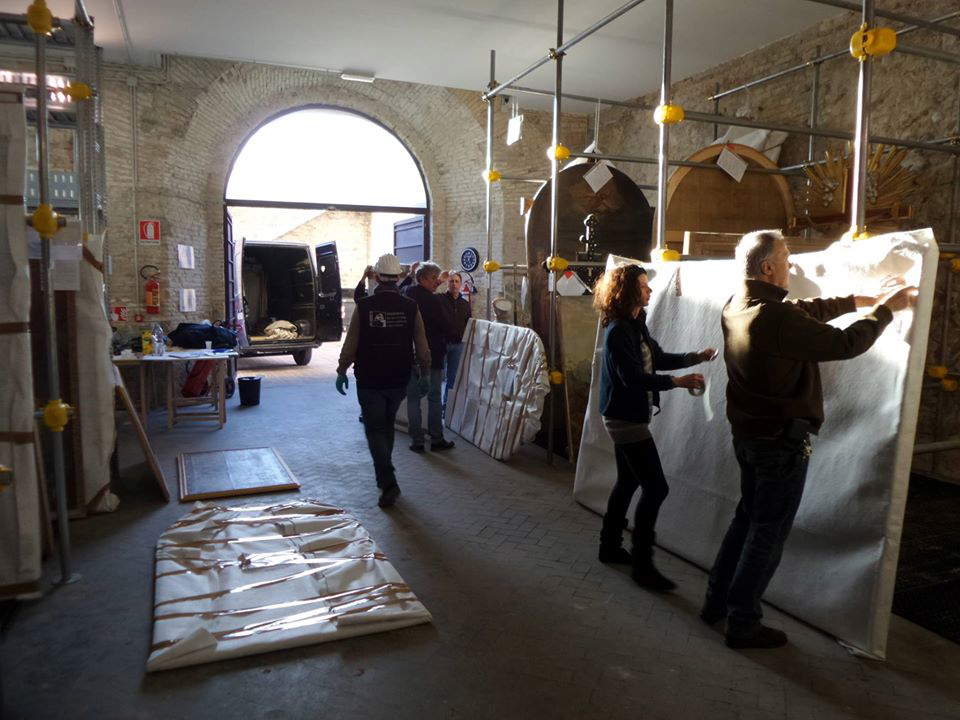 |
| The depot of the Mole Vanvitelliana in Ancona (photo MiBACT Regional Secretariat of Marche) |
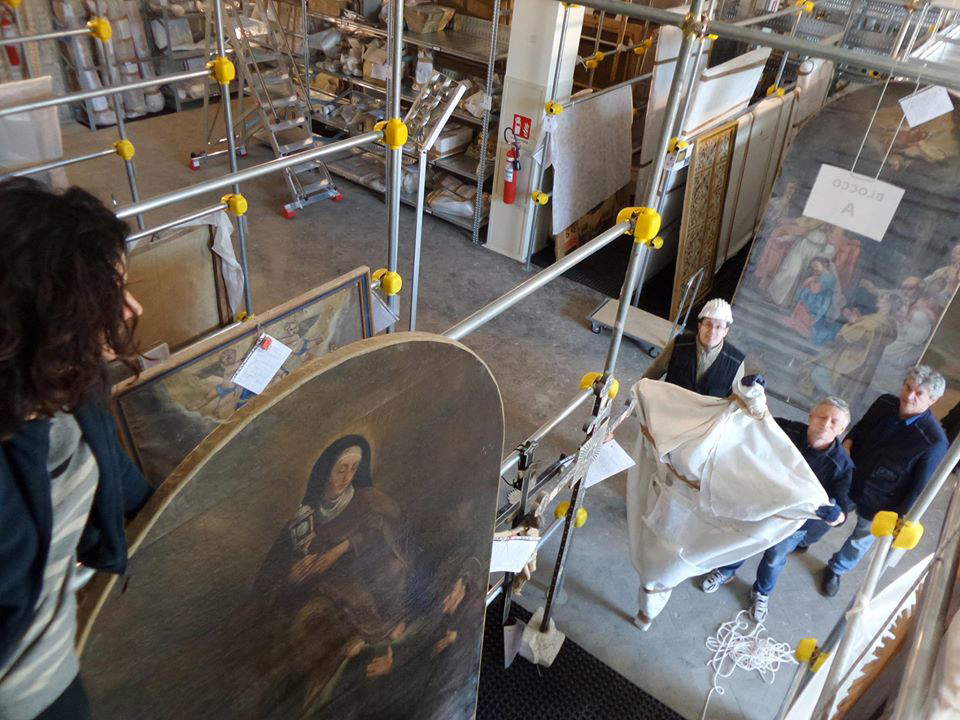 |
| The depot of the Mole Vanvitelliana in Ancona (photo MiBACT Regional Secretariat of the Marches) |
FG. More than three years have passed since the earthquake, and you were among the officials in charge of the rescue and recovery of works from the earthquake-affected churches. What do you remember about those days, the early days of the emergency?
PM. Those were terrible days. The rescue and recovery of the works began as early as August 27, after, unfortunately, the last victim of the earthquake in the area of Arquata del Tronto, in the province of Ascoli Piceno, had been pulled out of the rubble in the night. We understood immediately that the situation was very difficult and serious, almost all the very rich heritage of these areas had been destroyed (houses, churches, public buildings, stables, industrial sheds,..), the scenario that appeared was as if there had been a carpet bombing! Getting people to understand, moreover, that we were there to save and secure property ruined by the earthquake was even more difficult, because we had to operate in a context where people who had been saved had lost “everything.” But I remember that, having partially overcome the initial fear, some of the inhabitants, although, I repeat, they had lost “everything,” reported and asked us officials on the spot from the Ancona Superintendency together with the men of Lieutenant Colonel Carmelo Grasso of the Carabinieri’s Heritage Protection Unit in Ancona, to absolutely save at least the goods in the collapsed churches, to which they were very attached, regardless of their historical-artistic value. This is one of the reasons, in addition to the institutional one, that prompted us to carry out, capillarily, the recovery and securing of this vast and very rich cultural heritage. Consider that, as a general figure, after the two earthquakes of August 24 and October 26/30, 2016, 14,000 pieces (paintings, panels, sculptures, tabernacles, wooden altars, frescoes, liturgical furnishings,...) were recovered and made safe from churches, museums, monumental palaces and picture galleries alone. Works that were more or less important, but had a strong fondness and identity significance for the people of those places.
FG. In those phases, how was your work organized? That is, how did the rescue of the work, coordination, transfer to storage facilities and generally to safer places work?
PM. Coordination was the responsibility of the art historian officer of the Superintendency, who with the Carabinieri of the Nucleus and the Fire Department, would enter the buildings and determine which movable property needed to be brought to safety. After that, the militiamen would bring out the goods, which were filed and photographed, and finally there were volunteer people from the Civil Defense and Environmental League of the Marches, who in the outdoor spaces proceeded to pack them to preserve them in the best possible way. Then, with suitable means, the recovered and packed goods were taken to the warehouses, which at first were temporary improvised at the least worst, because unfortunately from this point of view we were not yet ready. But later on, within six or seven months, we “fixed up” all the eight warehouses in the area, setting up suitable metal structures to contain the goods, alarms, fire-fighting systems and whatnot. Now we can say that all the assets are allocated, filed and stored, as if they were in small museum facilities, although not yet open to the public. But for that we are thinking about it.
FG. Once the work finds a safe place after a catastrophe like the one that hit central Italy and is then transported to a storage facility, what are the next steps, that is, how are priorities for restoration determined, what happens to healthy works when a museum is no longer usable, how do you intervene on the works?
PM. We are now starting the third phase of the earthquake: the first was the immediate recovery of the assets, the second was the securing, and the third is the start of the restoration design of the assets to be recovered. For now, the designs of the assets in our MiBACT repository in Ancona, at the Mole Vanvitelliana, have started, but then we will continue with the three repositories in Camerino and the others (one in Fermo, one in Macerata and three in Ascoli Piceno), which were set up by the ministry but which also involved the curial offices and municipalities involved. All of the planning will be followed, as the contracting station, by the Special Superintendence for the areas affected by the August 24, 2016 earthquake in Rome, headed by engineer Paolo Iannelli, who will provide the financing, and we officials from the Superintendencies will carry out the tasks of Single Responsible for the Measure. Unfortunately, several recovered properties will not return to their places of “habitation,” since we do not know if the churches will be rebuilt, considering that some have completely collapsed. Geological and other problems will not allow reconstruction at those sites.
FG. As we said in the opening, more than three years have passed since the first earthquake tremors: where are we with the recovery of property?
PM. The recovery of assets is finished, except for a few situations for which, unfortunately, not even the technicians of the Nucleus fire department and carabinieri can find a solution. Fortunately, they are very few and in any case we are considering other solutions. In essence, we have recovered everything that was possible to recover.
FG. What about with the restorations and with the restoration of the buildings that have been declared uninhabitable?
PM. For buildings declared uninhabitable, my fellow architects in the superintendency are preparing reconstruction plans; an operation that takes head and time. For the restoration of movable property, I have already sent to the Special Superintendence of Rome the preventive plans, where all the operations necessary for the recovery and restoration of the works are highlighted. If all goes well, they will be cantierabili by early summer 2020.
FG. Why is it important to recover works of art affected by an earthquake and therefore why is it important to invest in restoration and recovery?
PM. It is fundamental: the assets, leaving aside for a moment the historical-artistic discourse, are identities for the people who inhabit those areas and, in addition, are also a source of economic sustenance, given the fact that the areas in question are frequented by tourists in both the summer and winter months, representing for the entire Sibillini area an important economy. However, what moves everything, primarily, is the attachment and predisposition of the inhabitants toward these assets. An example that may make better understand what I mean, happened in Arquata del Tronto: inside the Church of the Annunziata in Arquata del Tronto, the parish church that has now completely collapsed, there was a beautiful 13th-century polychrome wooden crucifix (which we saved), signed by two friars, probably Friars Minor of St. Francis: the people of Arquata were and are very attached to the crucifix. On August 28, 2016, four days after the terrible first quake, and still the church was standing, a gentleman, who had lost everything, was in the lower part of Arquata, in Borgo, where the fire department and civil defense had set up a small emergency reception camp. Having noticed my presence there in the temporary camp, he told me and recommended that we should definitely go to the Annunziata to secure the Crucifix, again he was a person who had lost everything. These are things that are striking and that we need to reflect on. I found, in the words of that gentleman, so many motivations that allowed us to go forward without ifs and buts: are we able to do that? Yes, good, so it is our duty.
FG. And it is a duty that comes back to the forefront. In recent weeks, the protection of heritage from catastrophic events has been back in the news because of the bad weather that hit Venice, Matera and several other cities in Italy. Here: what could be done to do more for prevention?
PM. Preventing these events is impossible, but safeguarding our monuments or limiting their damage is only possible with conscious routine maintenance, which unfortunately for economic reasons is no longer done. While, on the other hand, with regard to the necessary prevention in calamitous events such as those of earthquakes, specifically, it is imperative that the Marches equip itself, in time of “peace,” with equipped facilities/depots, ready to be used in any eventuality or natural disaster, because unfortunately we all have to learn to live with these phenomena of nature. And so here it is necessary to activate protocols, understandings, agreements with other structures working on the territory (Fire Brigade, Carabinieri, Civil Defense, Volunteers and others): we cannot think that everyone can do it alone. If there is already upstream coordination between the different entities and we know what the roles and tasks are, everything would be easier and faster. And that is crucial. For the 2016 earthquake, the start of the various recovery activities was very difficult, perhaps also because of the magnitude and amount of damage caused by the earthquake in Marche, compared to the other three neighboring regions (Lazio, Umbria and Abruzzo). In any case, I speak from my own lived experience, thanks to the commitment of everyone, MiBACT managers and officials, Carabinieri of the Nucleo Tutela, firefighters and volunteers, we managed to find a modus operandi that allowed us to work efficiently, quickly and in perfect harmony, which is very important in these uncomfortable situations.
FG. We have often heard complaints that the earthquake regions have found themselves in difficulty because of the lack of superintendency officials. What problems does this situation create for you?
PM. This is a problem we have had for many years. We know perfectly well that the superintendencies have very few employees and officials, which, moreover, is not only the case in our Ministry, but also in other ministries: there is no staff. And the Marches, because of its heterogeneous conformation and, above all, very rich in cultural heritage, is particularly affected. Having only two art historian officials is very little for the whole region, plus if we add the earthquake... but, I repeat, we still did everything that had to be done: “necessity makes a virtue,” an old saying goes.
FG. From the central administration did you get support?
PM. We never felt abandoned; they gave us all their help. From our central administration we were always told to do whatever needed to be done, after which the ministry would provide funding and support. Of course, had there been more of us maybe we would have done it sooner. Finally, to conclude, I would also like you to consider another aspect of the earthquake, which should not be underestimated, at least for me: during the inspections carried out for asset recoveries, especially until the early summer of 2018, while we were inside severely damaged structures, the earthquake tremors kept being felt, even if they were of medium strength, and it was “somewhat” scary, which is normal for human beings, but to me a particular fear came back: In the previous earthquake in September 1997, which affected Marche and Umbria, two of my colleagues and friends, Claudio Bugiantella and Bruno Brunacci, died in the collapse of the vault of the Upper Church of San Francesco in Assisi.
Warning: the translation into English of the original Italian article was created using automatic tools. We undertake to review all articles, but we do not guarantee the total absence of inaccuracies in the translation due to the program. You can find the original by clicking on the ITA button. If you find any mistake,please contact us.



























